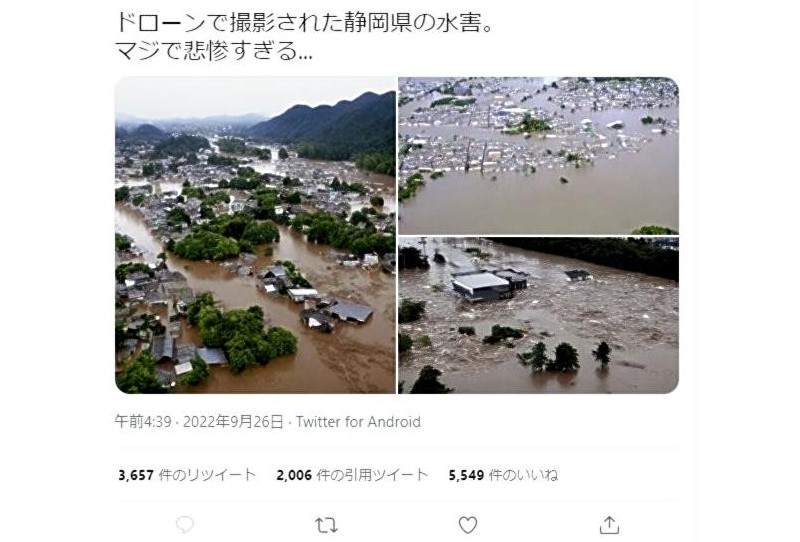Twitter user expresses regret over posts with fake images

A post on Twitter shows fake photos of houses and streets flooded in Shizuoka Prefecture due to Typhoon No. 15. They were made using a free artificial intelligence tool.
16:26 JST, October 5, 2022
A person who tweeted artificial intelligence-generated photos of flooded houses and streets in Shizuoka Prefecture, which the tweet said was the result of Typhoon No. 15, expressed regret in an interview with The Yomiuri Shimbun about having caused confusion with misinformation.
On Sept. 26, the Twitter user, who lives in Tokyo, posted three images at 4:39 a.m., accompanied by text saying: “Drone-shot photos of flood disaster in Shizuoka Prefecture. This is really too horrible.” The images show houses and streets submerged in water and mud.
The post was retweeted with comments like “Oh, no! “ and “We need to help those affected immediately.”
Flooding did occur in the area, but the images were fake.
Some pointed out unnatural elements in the pictures, including the unusual flow of water. The poster admitted that they were fake images and apologized for having posted them about 11 hours later.
One minute to make
The Twitter user employed a free AI tool provided by a U.K.-based developer to create the images, according to the user’s interview with The Yomiuri Shimbun on the condition of anonymity. With the AI, trained on about 2 billion images, pictures can be created simply by typing in keywords. The tool attracted attention after its release in August due to its precision.
The poster initially played around with the AI to make images of food. But, after seeing news reports about the typhoon, the poster decided to try to make images of a disaster.
On Sept. 26, the poster entered the words “flood damage” and “Shizuoka” in English into the tool, and the AI produced four images in about a minute.
The Twitter user then posted the images, except for one that was clearly unnatural. “I did not think of anything more than that it would be funny if people who saw the images were fooled,” the Twitter user said.
“I also thought they would figure out the images were fake if they magnified them. I never thought so many people would believe them to be real,” the Twitter user added.
Typhoon No. 15 caused a major water outage in Shizuoka City that affected many residents.
“I knew it wasn’t good to lie, but I couldn’t control myself. I also was happy to see the post get liked and retweeted. I feel bad about the trouble I caused people affected by the typhoon and those who believed the images were real,” the poster said.
Anyone who causes disorder through misinformation can be charged on suspicion of obstructing business through fraud. At the time of the Kumamoto earthquakes in 2016, a man was arrested under this charge after spreading misinformation by tweeting that “a lion escaped from a zoo” together with an unrelated image.
“If I’m called to account for the post, that’s the way it has to be,” the poster said. “Posting that kind of image can cause a big problem even if it’s just done on a whim. I want lots of people to learn from my mistake that things done without careful consideration can lead to big problems.”
Need to confirm authenticity
Technological advances are increasing the risk that people will circulate sophisticated fakes.
Some AI software can alter parts of a real image, and in February last year, shortly after an earthquake measuring an upper 6 on the 7-point Japanese seismic intensity scale in Fukushima and Miyagi prefectures, an image of the face of then Chief Cabinet Secretary Katsunobu Kato at a press conference was altered to show him smiling and was then posted on Twitter with a comment that said his expression was “inappropriate.”
AI can also generate images of faces of nonexistent humans, a function that has been abused overseas. After Russia invaded Ukraine, an individual impersonated a Ukrainian on social media and posted a message about the West betraying Ukraine, among other messages.
“Anyone can create AI-generated images, and it has become easier to distribute them for mischievous or malicious ends,” said Kazuhiro Taira, a professor of media studies at J.F. Oberlin University. “An increase in the number of images where authenticity cannot be confirmed could cause a negative impact in times of disaster. Even real images might be suspected of being fake, for instance,” added Taira who studies misinformation.
“It is important to take basic measures against these sorts of fake images, such as checking the authenticity of posts by studying the user’s past posts or by confirming the views of public organizations and experts,” he said.




